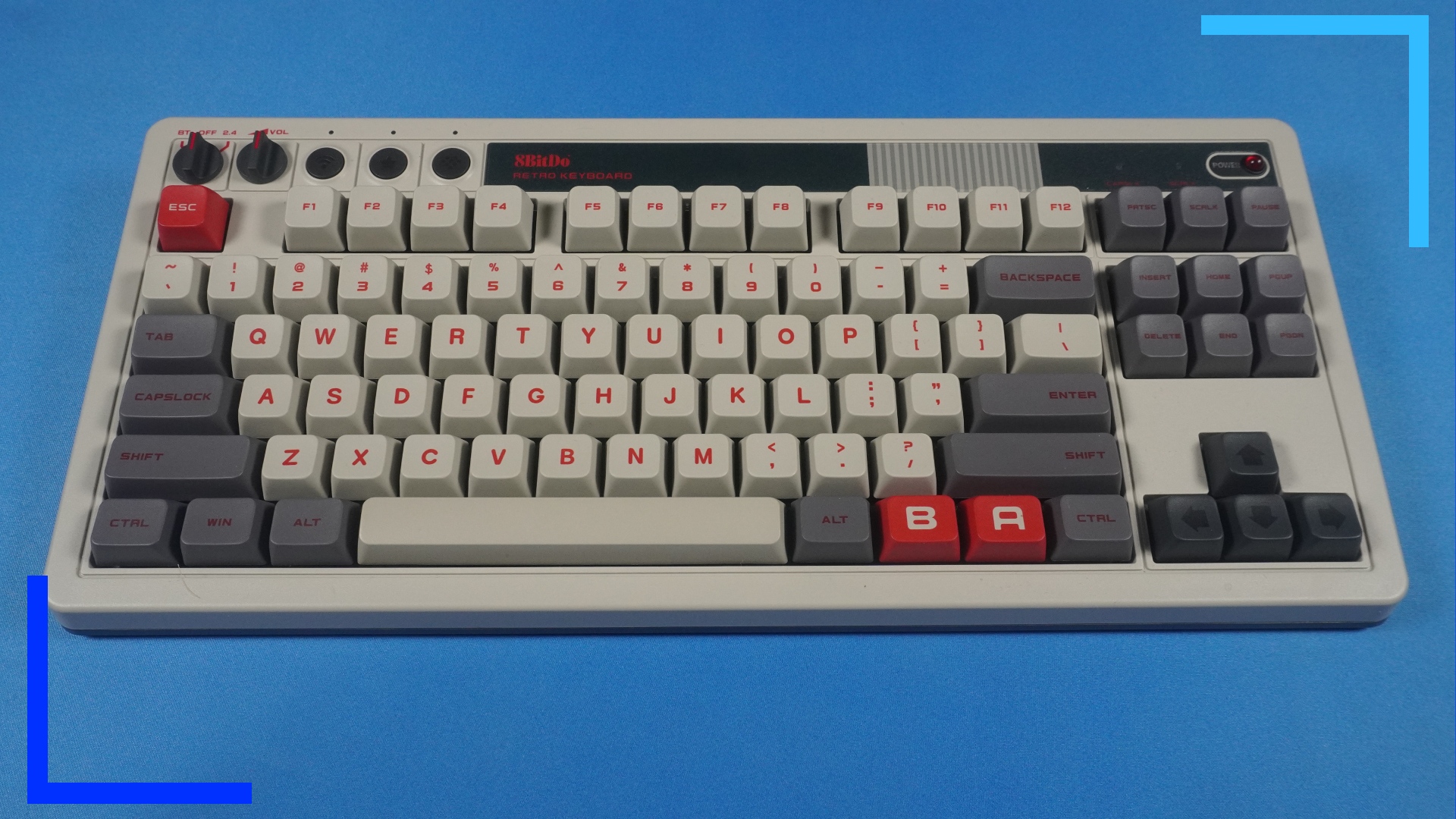Price at publication: $99.99 / £89.99 / €82.
What’s the most annoying thing about mechanical keyboards? It’s the sound. Most end up sounding like a blacksmith viciously pounding a hammer. The 8BitDo Retro keyboard isn’t the quietest around, but there is an attempt here not to wake the neighbors.
My sound level tool shows that a regular key press comes in at 59.6 dB. To put this in perspective, a non-mechanical keyboard I tested rocks out at 51 dB, while my generic flat keyboard generates 49.1 dB of noise. My kid’s RK Royal Kludge keyboard, meanwhile, blasts at 70 dB.
What we can take from this is the 8BitDo keyboard isn’t as quiet as flat or non-mechanical keyboards, but the difference isn’t excessive. If we compare the differences between the RK Royal Kludge and those same flat and non-mechanical keyboards, though, that’s where the differences are the most stark. In short, for a mechanical keyboard, it’s moderately quiet.
| Keyboard Noise Results | |
|---|---|
| Keyboard | Noise Levels |
| 8BitDo Retro Mechanical Keyboard | 59.6 dB |
| RK Royal Kludge Mechanical Keyboard | 70 dB |
| Trust Gaming Mini Keyboard | 49.1 dB |
| Generic Keyboard | 51 dB |
Gimmick or Feature Rich?





The biggest concern I had with the 8BitDo Retro Keyboard was that the NES-style aesthetic was going to carry it – that it’d be a classic case of style over substance. As it turns out, 8BitDo has implemented some pretty neat features that I now can’t live without.
The big one – and honestly I expected not to care for this – are the red B and A keys. Both of these keys can be programmed by pressing the Star button at the top of the keyboard, then the key combo and either the B or A key to map it. What does this look like in action? Let me give you a real-world use case.
It’s legitimately saving me time while I’m writing.
Take this review: I’m going to have to type out “8BitDo” several times throughout for obvious reasons. Company names like 8BitDo are a minor annoyance to type: Number key, hold shift while trying not to instinctively drop in a space, press ‘B’, type ‘I’ then ‘T’, hold shift while trying not to instinctively… You get my point. Multiply that style of typing by how often I need to type it and, like I say, it’s a minor annoyance.
On the 8BitDo keyboard, I’ve set the B key to perform a copy command (ctrl+C) and the A button to paste (ctrl+V). So whenever I need to type “8BitDo”, I can just press the A button. It’s legitimately saving me time while I’m writing!
I Didn’t ‘Get’ the Dual Super Buttons
The keyboard also comes with what 8BitDo has dubbed the Dual Super Buttons: Two massive disc-like red buttons you can program to perform certain tasks.
For me, I haven’t found a use for them I’m happy with. I did try using them when recording a video voiceover – one button to record, one to stop. But in all honesty, I found the compact nature of the B and A keys on the keyboard itself to be far more intuitive than having two dedicated oversized buttons.
I’m sure there’s a use case out there for them, but as someone who uses the main keyboard for writing and gaming on, the Dual Super Buttons feel almost superfluous.
It Feels and Looks Great, Mostly
The 8BitDo keyboard makes use of polybutylene terephthalate (PBT) keycaps, which means they’ll last longer than the standard mass-produced acrylonitrile butadiene styrene (ABS) keycaps. To the touch they feel great as well. PBT caps have an almost silky feel to them while also being sturdy and capable of dealing with repeated presses.
The only minor issues I have here is the dark red on select gray keys. It’s hard to make out in low light. If you know where the keys are, you’ll be fine, but if you’re unfamiliar with which key sits where that may be an issue. There’s also the problem the keyboard comes with a US layout, meaning some keys like “@” and apostrophe are switched. Normally this wouldn’t be an issue as you can pop the keys off and change them around, but as “@” occupies the “2” key, that wouldn’t be possible here. Oh well!
Editor’s Note: You can change your keyboard layout to American US on Windows if you want the keys to match.
How big of an issue is any of this? Not much to be honest. If you’ve been gaming for a while, chances are you’ll have enough muscle memory locked in to know where everything is. And, as mentioned, you can go into the keyboard settings of Windows and change the keyboard layout from UK to US if it’s bothering you that much.
Verdict



Photo credit: Wesley Copeland for RetroResolve.
Simply put, I love this keyboard. It’s chonky, feels great, offers up what I consider to be the right amount of feedback per press, and isn’t so loud that people around me are going to complain.
The minor gripes I’ve outlined above are just that, and shouldn’t be taken as a reason not to pick this fashionable beast up. The style is sure to delight first, but when you spend more time with the keyboard, you’ll realize just how much has gone into making it the best it can be. From the feeling of the keys to the excellent programmable options and the old-school dial knobs, this is one keyboard that justifies its price with ease.
Whether it’s for work or for gaming, the 8BitDo retro keyboard excels in all the right ways and is quite easily one of the best mechanical keyboards I’ve ever used. Who said you can’t have style and substance?

